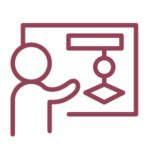What does it take to get your actions to align with your intentions? You’ll need to have a shared purpose, goal and plan for starters. But from there, how do you keep tracking? Our peer groups suggests “backing up — reconsider, redefine, rethink, rewind”. And what do you do when you hit blockers, can’t get over the hurdle or reach a plateau? This is when it’s time to get creative.
The ideas and stories captured here were shared by members of the Regional Innovator’s Network (RIN) during a peer learning session on 10 May 2018.
Quick summary
What does it mean?
- Being intentional
- Coming together around a purpose
- Setting goals
- Planning – so that everyone’s actions are coordinated
- Clear roles
- Checking how you’re going against your goals
What helps
- Setting milestones and creating regular habits
- Making sure the critical people are at the table
- Celebrating wins and acknowledging how far you’ve come
- Paying attention to energy and momentum
- Backing up — reconsider, redefine, rethink, rewind
- Figuring out how to get over the hurdle – or skipping it altogether
- Connecting with others who are trying to do something similar
What hinders
- Sticking to your plan if it’s not working well
- Thinking of it as a linear journey – perhaps think of it as tending the garden
- Getting discouraged when you can’t get over a hurdle, hit a blocker or reach a plateau
What does it mean?
Being intentional
Intention, intention, intention. Setting intent, checking against intent and getting creative to reach intent. To be able to think and act strategically, there must be a real purpose behind what you’re doing, but also a clear goal. Your ability to think and act strategically depends on how well you’ve articulated the “why” you are here and the “what” you will achieve. Being intentional also means coming back to that purpose and goal at every decision.
“Intention – planning for your goal with a real purpose”. – Anne Shortis, Manager, Trainer and Educator at Education & Training Out West (ETOW)
Coming together around a purpose
As early on as possible, a group of people will need a purpose. Why are you here? For instance, a group coming together to work with unemployed youth could be there to help them get new certifications and teach employability skills or to help them create connections and support with their peers.
Setting goals
What is your goal? What are you trying to achieve? The goal will directly determine your plan. As an example, if a group of people come together to play footy, their plans will be very different if they are there to win the state championship, focus on their ball handling skills or just have fun and make friends. List out a few different goals and try them out. How does your focus change depending on the goal?
Planning – so that everyone’s actions are coordinated
For people to work together, they need a shared sense of how they’re going to get there. What tasks will get you to that goal? Whether the plan is in your heads, on the back of a napkin, on a whiteboard, in a spreadsheet or managed by complex software — a group of people working together need a plan.
When you have a group working together on complex social change, it can be helpful to work with a planning tool. At TACSI, we often create a Theory of Change <link to the tool in the platform> to identify the outcomes we seek to achieve as well as the ‘building blocks’ that will help get us there. The Theory of Change is a way to set out our assumptions about how change will occur, and what we need to get there. As we move through the process, we can check to see what really works and keep updating our Theory of Change as we go. A Theory of Change is most useful when you update it regularly, and when it’s written in language that everyone recognises. A good plan is useful, tangible, grounded – and doable.
Clear roles
Part of planning is also getting to an agreement as to who will do what. What role will each person play, are they happy to do that role, and are they equipped to do that role? Do they need support? An example of framing clear roles is the work that we have developed with the Children and Prison Program (CAPP) group in Dubbo where we have generated a framework that describes how the group is going to work together across the three identified groups: creating the conditions, knitters and co-design. You can read more about this in Dubbo case study here .
Checking how you’re going against your goals
Pausing and reflecting on your original intentions on a regular basis is useful. It helps a group to recalibrate. But it’s also important to help you acknowledge those wins and how far you’ve come.
What helps?
Setting milestones and creating regular habits
Breaking your plan down into smaller, more manageable milestones and actions can really help to make the goal doable. Having regular habits, maybe even daily habits – like a morning meeting – can help to provide structure to the work and keep everyone focused. Having a rhythm of tracking against milestones and setting habits that keep you focused are important parts of maintaining sustainable momentum.
Making sure the critical people are at the table
Having key people with power, influence, resources at the table – in addition to the people doing the work – is a clear signal that what you’re doing is important. It also can be a blocker when these people are needed and they’re not around. What does it take to get the key people there, and how can they signal to everyone else what’s important? This is not always easy in a regional context because there are some boundaries – physical or structural – that can make it hard to get the right people at the table.
“We’ve often identified that our work is the other way around. We don’t have the critical people at the table yet. We’re trying, we’re trying consciously to add to our alliance to ensure that where we identify gaps in momentum or the inability to open doors that we’re filling them with the right people. But some of our boundaries have caused quite a lot of barriers out here – we don’t have managers and they can come from different areas (e.g. Parkes, Dubbo).” – Shane Phillips, Lake Cargelligo Community Connector
Celebrating wins and acknowledging how far you’ve come
Where were you when you started? What were you capable of? What couldn’t you do? What have you achieved and where are you now? It’s so important to notice when you or the group have achieved something, and to observe just how far you’ve come on your journey.
Paying attention to energy and momentum
Is the group’s energy and momentum right to accomplish what you’re trying to do? If so, power on, and keep building that energy and momentum! If not…
Backing up — reconsider, redefine, rethink, rewind
Regroup and have a look at what you’re trying to do. Is it really the right thing to do at this point in time? Do you have all the resources you need? Is everything in place? What might you be missing? Do you need to build the energy and momentum up again? How might you do that?
Figuring out how to get over the hurdle – or skipping it altogether
Along the journey there will be hurdles – things you need to get over or through in order to achieve your goals.
When we do our planning…we think it’s going to look like this: (thanks Subway)

Sometimes it looks more like this:

Maybe there’s another way…

Remember that the journey isn’t linear! In doing the messy work with communities, people and the many moving parts that are involved, sometimes we don’t actually have to go over a hurdle in order to keep going. Sometimes there’s another way around, a more graceful way. If that hurdle really does need to be jumped, it’ll still be there at a later date, maybe when you (you or the group) are better in step and have more momentum.
Connecting with others who are trying to do something similar
Can you find peers? Who else is trying to do this work? Who has been there before? Can they help cheer you on, give you ideas, share stories? Or even just hold you accountable to your intentions? Having someone in your camp can make a huge difference.
What hinders?
Sticking to your plan if it’s not working well
As you get into a project, more often than not your plans will completely fall apart at some point. Don’t stress! The map is not the territory. Check what you’ve learned about your situation and what you’re trying to accomplish. Review the facts, review what’s happened. Make a new plan, a plan that better works for your reality. Bring people together around this new plan, and help them stay excited about where you’re headed.
Thinking of it as a linear journey – perhaps think of it as tending the garden
Sometimes when we make a plan it tricks us into thinking that the journey we’re on will be a straightforward one. Working with people and community is rarely straightforward! It’s not just about zigging and zagging. The playing field you’re on is changing constantly, new hurdles appear seemingly from nowhere, and sometimes old hurdles don’t go away — even after you’ve made it over them more than once.
To be fair, some of our projects are more like races. There is a clear finish line, and the tasks can be clearly shaped and defined in order to get there. People can be supported and nurtured to help them through the parts they find hard. And you get there and it’s AMAZING, transforming.
But in the long run, work in regional areas is less like a race and more like gardening or farming. In gardening you are forever trying to work with the seasons, the weather, the pests, the weeds, the many layers and aspects of a garden to make all the conditions right, while trying to nurture each and every plant, flower and fruit so that the people you are trying to serve, you, your family and your community are in turn nourished.
Getting discouraged when you can’t get over a hurdle, hit a blocker or reach a plateau
Sometimes you make initial progress quite quickly. Perhaps armed with a few new skills, a keen attitude and opportunities you are able to really make tracks. But then you hit a wall, a plateau. The learning, growth and progress seems to stop. You can get discouraged, lose momentum and sometimes lose your way, even forget your purpose.
Connect back. Find that purpose again. Remember how far you’ve come. Can you remember a benchmark – something that shows you where you were, and where you are now? You’ve proven you can make progress. You can continue. Don’t get discouraged! Hold onto that hope. Perhaps even find someone to work with you who can help you hold onto that hope.
When you hit a roadblock or reach a plateau, your goal can seem too far away – impossible to reach. But often it calls for a recalibrate, rethink and reset: recalibrate based on how far you’ve come, rethink your expectations, reset your milestones, check your strategies. Are your strategies working? How could you approach it differently? Can you break your goal and milestone down into smaller goals and milestones? When you hit on a place where what you were doing doesn’t seem to work and you don’t feel like you’re progressing, don’t give up your goal, don’t give up your hope and don’t give up on searching for a different strategy.
Tap into your deep creativity and problem solving. How can you think of things differently? You might be able to find another way. Keep trying, find something that works.
Frameworks
- Tool “Theory of Change”: What makes you think your actions will lead to your desired outcome? You’ve got an idea of how this will work…Somewhere in your thinking, there are links! Put them on paper, connect the dots. Track your actions and the outcomes – trace how your assumptions play out over time. Figure out what really works to get outcomes
- The importance of community mapping by Primož Kovačič (10 minute read article): https://innovationsjournal.net/the-importance-of-community-mapping-b751a0dd509e
- A fair development vision for Baltimore, short video (3:22 minutes): https://vimeo.com/172476472
- Tomorrow documentary directed by Cyril Dion and Mélanie Laurent (118 minutes): https://www.tomorrow-documentary.com/
- “The art of war” by Sun Tzu (128 pages): https://en.wikipedia.org/wiki/The_Art_of_War
- How to Measure Progress in Your Personal Goals by Belle Beth Cooper (5 minutes): https://blog.bufferapp.com/how-to-measure-progress-in-your-personal-goals-daily-weekly-and-monthly
Resources
- Templates that we have created to explore this capability (attached)
Related capabilities
- Making and learning: Is there a method to your madness? A (frame) and try-test-learn loop can help you systematically think and act towards your broader goal. Read about an approach shared in this section, and see how it can be applied to your work.
- Making it happen: Putting the “action” in thinking and acting strategically. What do you have to do to “make it happen”? Where to you find the determination, how do you keep the energy and momentum going?
- Facilitating meaningful and productive conversations: When you need to come together to identify a purpose, set goals, create a plan, work through blockers and strategise, it can be helpful to have a facilitated conversation. Sometimes an external facilitator is needed, but other times all you need is an intentionally facilitated conversation.
- Catalysing change through the right partnerships
- Maintaining energy and passion





